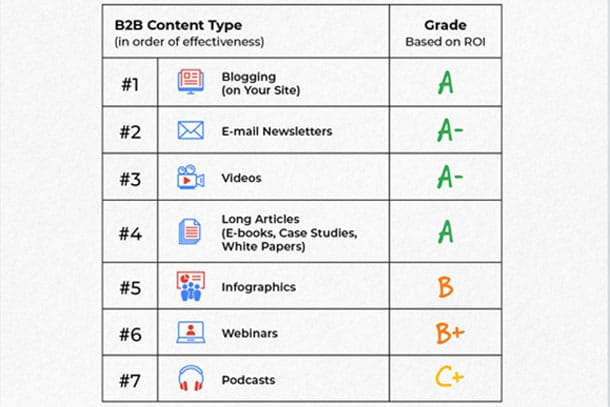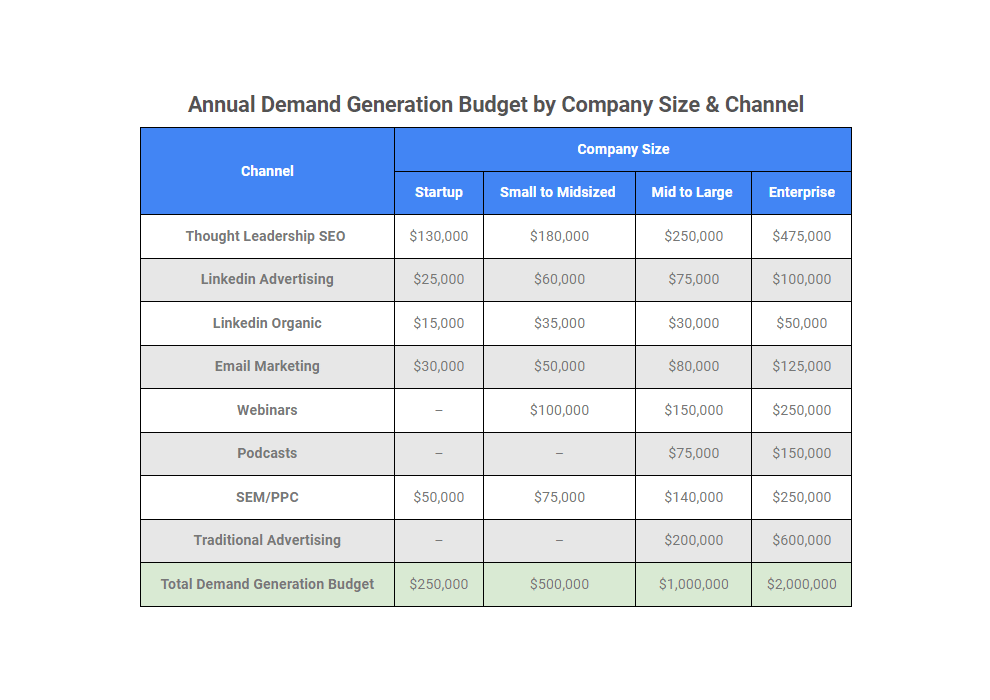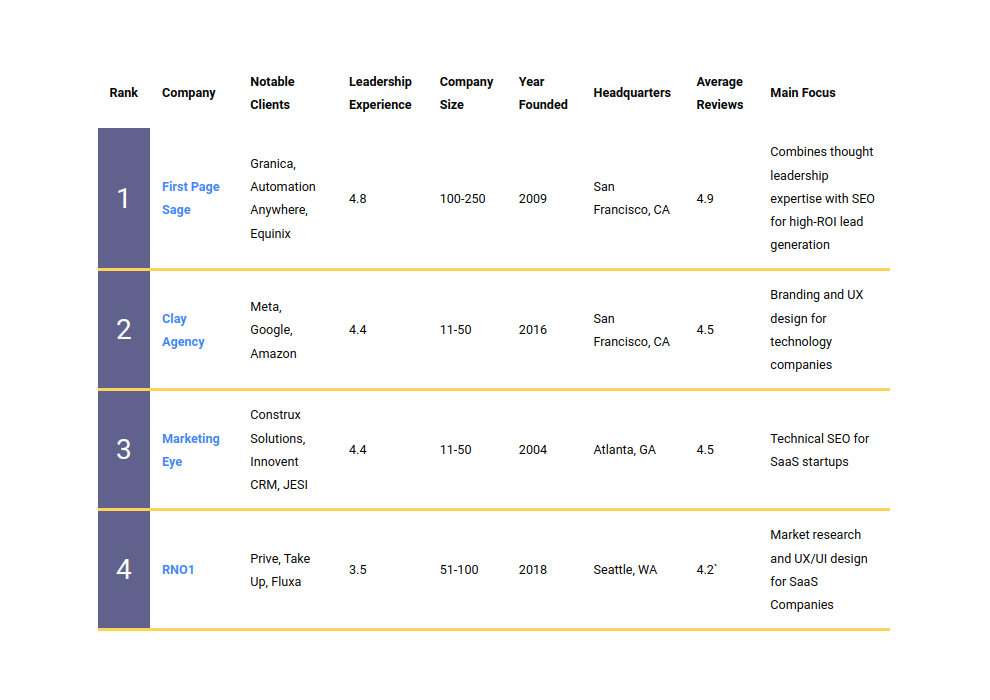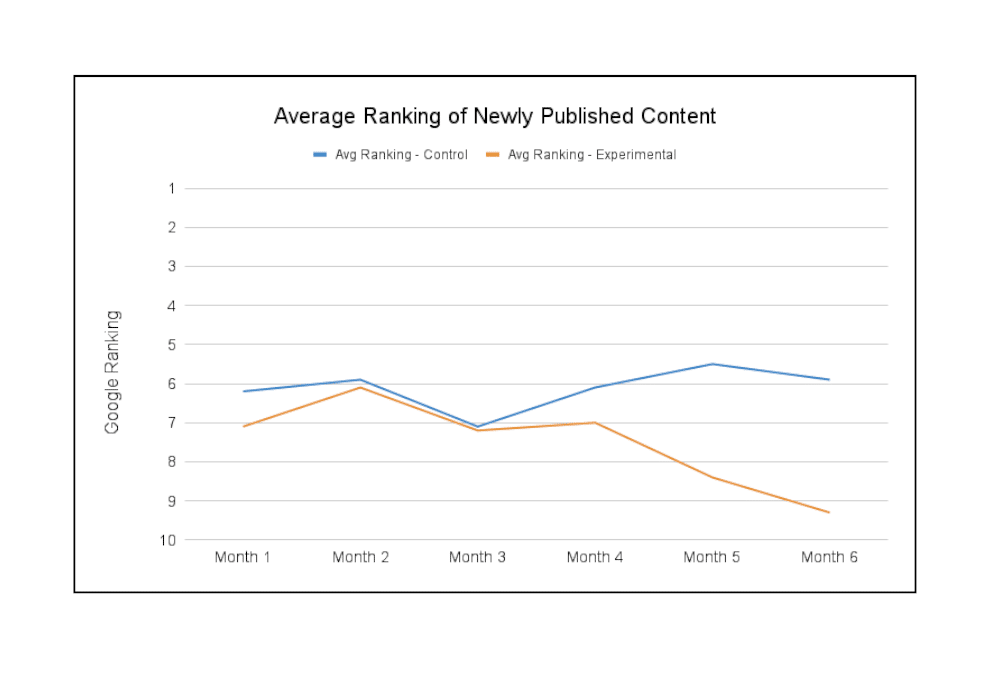Does your company already use some type of content marketing? Probably. Nine out of ten B2B businesses do. That’s because this common strategy—providing useful information online in return for product or service visibility—has been proven to work. That’s also the problem.
So many B2B businesses do content marketing that almost every industry is saturated with content. Therefore, to get results, you need to stand out. And although it may not sound intuitive, I’ve found that simply varying the type of content you produce from the standard, 500-words-and-a-stock-image blog variety is very important. But which type is best for you? To help with that question, we’ve created a list of the content we’ve found to be successful and rank, ordering each type based on ROI.
Of course, not all content is created equal. Like everything from sausage meat to spelling tests, content comes in grades. Whether you’re producing a blog, a podcast, or a video series, quality matters. And since content type and content quality are different concepts, I’ve made sure to cover both below.
B2B Content Marketing Ranking Chart
Here are the different types of B2B content marketing, ranked by their ability to generate ROI. I’ve included the three grades of content quality—filler content, standard content and thought leadership—so you can consider whether it’s worth the extra resources to always get the highest quality version of each type of content.
| B2B Content Type (in order of effectiveness) | Grade based on ROI |
| #1: Blogging (on Your Site) | A |
| #2: E-mail Newsletters | A- |
| #3: Videos | A- |
| #4: Long Articles, E-books, Case Studies, White Papers | A |
| #5: Infographics | B |
| #6: Webinars | B+ |
| #7: Podcasts | C+ |
When developing the grades above, I was considering two things; the amount of time (and money) a piece takes to create, and how much potential value it can provide a company.
Blogging provides the highest ROI of any type of content marketing. Several factors explain why:
- Text remains the most popular mode of search, giving text articles and landing pages the greatest audience
- Writing costs less to produce than video, audio, or graphics
- Blog articles provide the simplest references for return visitors
- Articles and landing pages put fewer clicks between customers and conversions
So many companies publish blogs as standard content on their websites that good enough isn’t good enough to stand out. To appear on the front page of search results—the only place to appear at all—companies have to publish thought leadership. That’s best-in-class content that finds a home at the top of your customer’s thoughts.
Consistent publishing of thought leadership articles on your website is foundational. A comprehensive thought leadership strategy builds on this foundation by including the other types of content marketing.
Videos, podcasts, and infographics can all feed into blog articles, white papers, and landing pages. Each content type multiplies the reach of the blog and articles by introducing a company’s published knowledge to a new medium. But in order for them to work, they must be built on a solid blog first.
Types of B2B Content Marketing
The most common type of B2B content marketing is blog and article publishing on your website. Content marketing didn’t exist as a phrase before blogging. Other types of content marketing developed to imitate and to augment blog articles and landing pages. Each serves a unique purpose. Together, they form the backbone of a developed, robust thought leadership strategy.
Blogging
Publishing written articles and landing pages on your website is primary. This literally is your website. Landing pages tell your customer who you are and what you do. Blogs and other articles allow customers to find you online, by providing the answers they’re looking for on search engines. The best answers get seen by the most customers. Each article leads back to your landing pages, funneling customers to your products or services.
Email Newsletters
It doesn’t take long to send an email newsletter, and it doesn’t take long to delete one, either. And that’s exactly what happens to spam or filler-quality email newsletters. A customer’s inbox, whether or not your email was invited there, is a crowded, competitive space. To stand out, high quality email newsletters provide immediate value in the form of important, useful information. Often this information is repurposed from your blog, helping keep costs down. Because of the low cost and the high potential that comes from leveraging pre-existing contacts, email newsletters are frequently worth the investment.
Long Articles (E-books, White Papers, Case Studies)
TLDR. That means “too long, didn’t read.” There is so much content competing for potential customer’s attention that if they can get the point in 10 seconds, there’s a very low chance they’ll keep reading for another 10 minutes. That said, as reference works to be returned to over time, e-books, white papers, and case studies can provide a return on the large investment of time and expertise it takes to create them. The difference is quality—to earn the continued attention of your readers, a long article absolutely must be irreplaceably valuable on the internet.
Video
Videos can be attention-grabbing and immersive, and can enthrall your audience. Video content marketing can include how-to videos, product demonstrations, customer testimonials, or training information. Although YouTube does provide video-only search results, few if any companies have a video-only content marketing strategy, for several reasons:
- Video is the most expensive type of content to produce.
- Videos require landing pages to host them.
- It’s hard for viewers in a hurry (like busy CEOs) to skim a video—more likely, they won’t click Play.
- Video is more difficult to reference or use as a source. Unlike a blog article, you can’t see all of a video at once, and the speakers can only say one word at a time.
- Customers can’t only click on links embedded at the end of videos, and that’s assuming they watch the whole thing.
That’s not to say that video can’t be an effective form of content marketing. But, given the relative costs, video should be saved to augment regular blogs and landing pages. The extra investment required to create a video demands that the video provide extra value.
Infographics
Infographics typically include a series of facts overlaid onto an image or diagram. Colorful, enticing, and informative, infographics, like video, can helpfully augment landing pages and blog articles. Also like video, they can’t stand on their own. Landing pages provide homes for infographics, while blog articles help explain and promote them.
Webinars
Webinars take a significant investment of time, both for the producers—your company—and your audience. They can lead to a worthwhile payoff, as an engaging, informative webinar will increase audience trust in your company and stick in their head in a way an email won’t. But this is a double-edged sword—a boring, uninformative, or badly produced webinar does more to drive potential customers away than less-involved marketing types.
Podcasts
Podcasts have been described as a form of B2B content marketing, mostly by content marketers looking to sell you podcasts. Many statistics have been touted to prove how commercially viable podcasts or “audio content marketing” can be for your company.
Typically, they cite the rising number of people listening to podcasts. While true, more people are listening to podcasts, there are still far fewer total listeners than there are people searching text or video. Also, while podcasts cost less to produce than video, they still cost more than blogs. That’s in part due to their technical demands—equipment, software, and personnel—as well as their serial nature. One podcast is not enough to rank; companies must invest in a campaign.
That’s difficult to justify, as podcasts are not transactional. It’s impossible to click on something you hear on a podcast. When you consider that people intentionally listen to podcasts when they’re doing something else—commuting, cooking, shooting rubber bands at the ceiling—it seems even less likely that people will stop what they’re doing in order to search for your product or service.
That’s not to say that podcasts have no use. Developing a successful, long-term podcast can position a company as a thought leader in their field. To do so, companies must provide hours and hours of useful, relevant information—and retain a charismatic host to present it. Building a following takes time and dedication, but can slowly, eventually, position a company as a thought leader in their field. Of course, enticed listeners seeking transactional information then must travel from the podcast to a blog or landing page to contact your sales team.
Building a Comprehensive Thought Leadership Strategy
Building a comprehensive thought leadership strategy requires a strong website and blog. Once those foundational parts are in place, then companies can consider integrating other types of content marketing into their thought leadership strategy. Select, carefully-chosen videos can answer transactional search queries, showing products and services in a way text cannot. Embedded infographics can bolster blog articles, and make ideal images to share with articles on social media or newsletter. Podcasts should be left for last.
No matter what types of content your company produces, it must meet a certain standard. Spam is a waste of your time and everyone’s money. Cheaply produced filler content is little better. It might not insult your audience like spam, but it won’t convince them either. Standard content can provide useful information, but it’s not enough to rank on Google or be remembered by your customers. Thought leadership positions your company at the front of your client’s mind.
Developing a comprehensive thought leadership strategy takes hard work and expertise. Our dedicated, experienced team can augment yours. Or, contact us if you want to fully outsource the job to B2B content marketing specialists.



